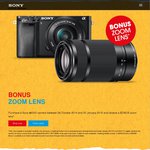Hi, this is my first post so I'm not completely sure how to work this.
Sony is giving away a free 55-210mm zoom with their a6000 camera at most retail stores in Australia. The cheapest deal I've found is at the Sony Store in Nunawading, they have a A6000 + kit 16-50 + 55-210 for $793. No body only.
Ted's have body only for ~$750 and is supposed to come with the 55-210 as well, but the with the 16-50 the cost is $1000.
http://www.teds.com.au/sony-ilc-e6000




Tip One - Don't write "This is my 1st post".
That's what the big yellow L is for.